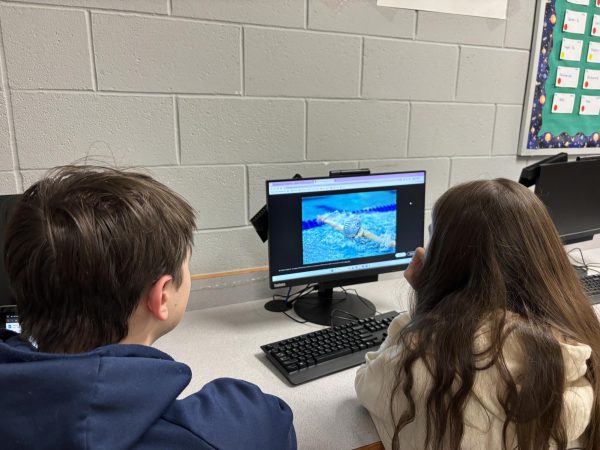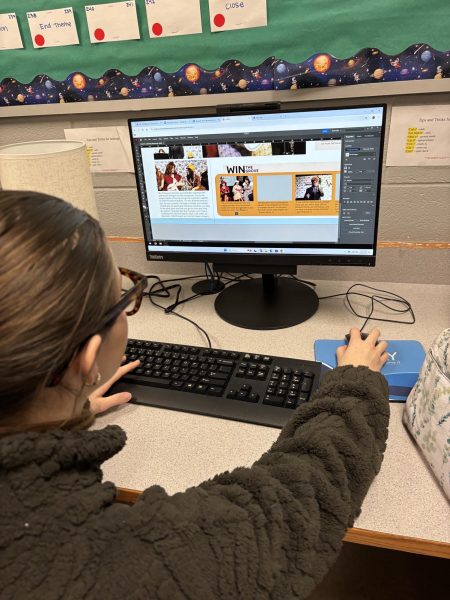
Walking into a classroom, there is an atmosphere like no other. With students chatting, editing, and cameras ready, they are ready to make a yearbook.
This is how Yearbook students work to create the Yearbook: They try to be as organized as possible while worrying and working hard. Together as a class they learn from each other, and their mistakes. Whether it’s taking photos or writing pages, they all help each other. When doing interviews they meet new people, and learn how to speak better in public or presenting. Many skills come out of this class, and so do memories.
Many of the Yearbook students find the class fun and creative. Students learn communication skills and creativity from each other within the class. Junior Coco Mercker commented, “I just wanted to do something fun, something with community.” Other students have agreed that it is a fun, and very inclusive class. Senior Mackenzie Sonak also shared, “Last year I think I really got into yearbook because I had a lot of fun making the pages, and it was a nice class where I got to be creative.”
To make the yearbook, there are many steps and things to prepare for, such as deadlines, photos, printing pages, and outlines. Instead of sending all of the yearbook pages at once, they send them systematically to reduce confusion and chaos. Once they submit pages to the manufacturer, they print them out on a sheet of paper, and place them into the book.
Every year, the Woodgrove Yearbook staff publishes a 244 page yearbook and 20 page spring supplement. The entire book is created using digital technology. The Yearbook staff works, communicates, and connects during class to make the book. Senior and assistant editor Audrey Smith mentioned, “We use a lot of Adobe apps, Adobe indesign is where we put the pictures and the captions in.” The book is completed around May because there is a supplement that is put into the back of the book. The supplement usually includes all the events after their April deadline. Last year, they included the eclipse, Grease the Musical, Music, Prom, and more.
For the students who are making the yearbook, it can get stressful from time to time. Throughout the year there are many deadlines to cover and finish. Instead of finishing everything at once, the deadlines are spread out to organize the work. Spreading it out helps a lot with less chaos and missing work. Smith explained that “you have to meet deadlines, that’s the biggest pressure that you have, you have to meet your deadlines.” Everyone has experienced deadlines and how stressful they can be. When working on the yearbook, there’s the pressure of what people want to see in the yearbook, and what they don’t want to see. Within the class, students learn how to deal with real-world situations, and how they can use their skills from Yearbook to save them in these problems. Smith emphasized “I think, definitely the communication skills that I’ve learned. I’ve learned how to talk to my peers in a professional way almost, and definitely leadership because I’m an assistant editor, so in my future endeavors, whatever I end up doing, I’ll be able to effectively lead.”
Overall, the two classes have good communication between each other. There are times when it can get a bit disorganized, “There is another yearbook class and it gets kinda hard because we talk through Olivia, and their editor, so it just gets a bit messy” claimed sophomore Savannah Maresca. Another student also clarified that there is good communication, “but something we’re trying to implement is weekly meetings to make sure we’re all on the same page” added Mckenzie Sonak, senior Editor in Chief. Communication is very important to this class to keep in touch with everyone, and to keep everything from falling apart. Sonak also stated “the communication within my personnel

All of the students work hard equally to put together the book. This class is a place where students can find their interests, collaborate with each other, have fun, and so much more. “I got to meet a transfer student who’s a junior this year. Me and him have gotten really close,” stated Maresca. Maresca’s statement means that you make new friends and connections throughout the year. They meet new people from doing interviews, classes, and events, along with their school.
The togetherness and teamwork radiate off of each student. Smith agreed, “During the class, and outside of class we really work together and we bounce ideas off of each other.” Each student has someone in the class to work with, and still have fun while doing their work. Mercker expressed, “We work hard, but at the same time we have fun, and we’re all friends. It’s a good environment.”
To the students, this book is more than just a book. The yearbook shows the different triumphs, and emotions the students express in each page. Friends, teachers, and the Yearbook students who create the yearbook make it possible for others to enjoy the book. “I definitely think it’s more than just a book. I think it’s a really great way to hold memories. Personally, I’ve bought every yearbook of my highschool career. I think looking back at those memories especially from freshman year, it means a lot to be like, ‘Oh yeah! I remember that happening’, all the events and stuff that you might forget.” Smith continues, “Maybe 40 years down the line you can look back and see all the people you went to school with, and it really means a lot.”


